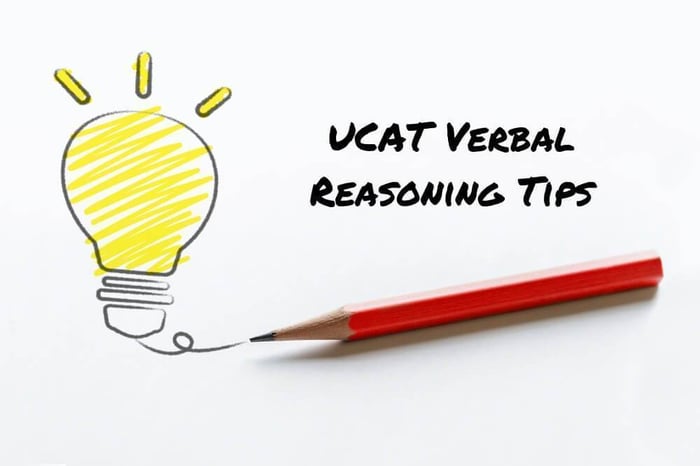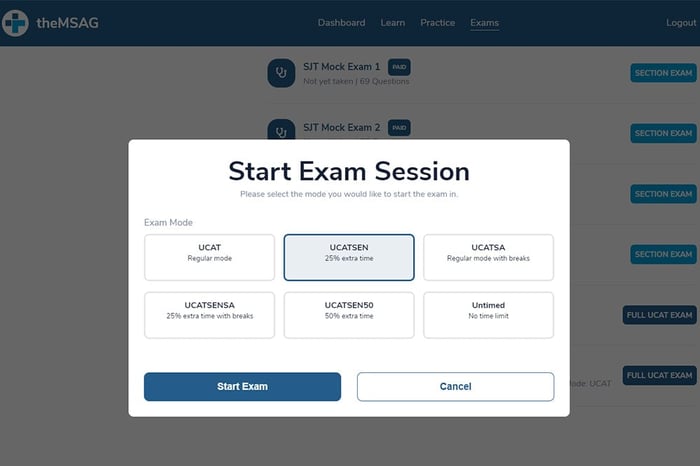The Verbal Reasoning section of the University Clinical Aptitude Test (UCAT, formerly UKCAT) is largely one of the most feared and dreaded subtests of the exam for many medical school candidates. The aim of the Verbal Reasoning test is to assess your ability to read and comprehend an unknown block of text and evaluate it. There are then two question types. The easier of the two is called ‘True/False/Can’t Tell’ questions. On the basis of the information in the passage of text presented to you, you will be expected to answer whether a statement is true, a statement is false or it cannot be concluded from the information given, known as ‘Can’t Tell’.

The other question type, apart from true or false questions, we call ‘Statement Questions’. Here, you need to evaluate all answer options given and decide which one is correct, most/least likely or complete the sentence, based on the passage provided. The UCAT Verbal Reasoning time for this section gives you 21 minutes to answer 44 questions, so even solely from a timing point of view, it is understandable why this is such a feared part of the exam. Not to worry, as we are here to give you our best tips on how to ace UCAT VR. For more information on Verbal Reasoning, check out UCAT Consortium’s official website and our blog post, UCAT Verbal Reasoning Overview.

| Questions |
Time |
Question Types |
| 44 Questions (11 passages) |
21 minutes* |
• True/False/Can’t Tell
• Statement Questions |
*For those with extra time in exams, take a look at our UCATSEN post to see how much time you could have.
1. Practice Skim Reading
As we said, the aim of the Verbal Reasoning portion of the exam is to see how quickly you can abstract information from a large amount of text. You will be presented with an obscure text that you will probably have never seen before and then UCAT VR will ask questions related to the passage - make sure you only use the information given and not your own knowledge!
The quicker that you can read the information the better so our first tip is to practice skim reading. Practice reading blocks of text and see how much information you can remember - can you read it even faster and still remember the same amount? Often, we read at the same speed at which we speak. However, our brains are capable of taking it all in much quicker. Try reading a passage and moving your finger along slightly faster than you are reading. This will naturally make your eyes move along the page faster. The more you do this, the better and faster you will become at reading and comprehending complicated and obscure pieces of information, which is an essential skill to have for the Verbal Reasoning part of the UCAT.
2. Practice Scanning the passage
This may seem the same as tip number one, and both scanning and skimming involve moving through the text quickly, however, there is a crucial difference. Skimming is used to give you a general summary of the material while scanning should be used to find specific information. Once you have become comfortable skim reading and comprehending and summarising unfamiliar texts, the next thing on your mind should be your timing to find the necessary phrase to answer the question. With 44 questions to be answered in 21 minutes, you will be very time-pressured if you haven’t trained to scan. While attention to detail matters a lot in Verbal Reasoning, speed is also very important. To scan, simply choose a word and then move your eyes as quickly as possible through the passage looking for that word. Be smart about the word that you choose though! If it appears too frequently in the passage it’ll become more of a time-waster than a time-saver.
Try turning this into a game with friends or family! Split into two teams and take it in turns to pick a word in the passage and give it to the other team. Time the guessing team to see how long it takes them to find the word and give points for every second they take. The team with the least number of points wins!
3. Move to timed practice
With these two tips under your belt - it's time to move to timed practice. This is essential for your UCAT Verbal Reasoning time. The often frustrating thing about the Verbal Reasoning section is that you know the answers are all there. Unlike other sections, such as Quantitative Reasoning, where you have to work it out, in VR, all the answers are there on the page for you. The trick is - you have very little time to find them! Moving to timed practice early on in your preparation ensures that you know you are on the right lines and don’t have any nasty surprises a few days before your test. We offer a
free practice test on our Question Bank - its the only UCAT Question Bank design to improve your speed. It will give you advanced analytics into your timing, areas where you are wasting time and how your timing per question compares to your peers.
4. Understand UCAT VR Language Techniques
The Verbal Reasoning section uses different language techniques that, if you know and understand them, can ensure you are choosing the right answer every time. For example, did you notice a future prediction? Often that’s an indicator of a ‘Can’t Tell’ answer since these are less likely to be factual. Other language techniques that you may see include:
- Soft and Strict Qualifiers
- Objective v Subjective statements
- Subtle Differences
- Assumptions
Make sure you understand what each of these means and how they could be leading you to choose the wrong answer in VR. Need a bit more help? Our £40 online UCAT course has a video dedicated to each one of these to be sure to check it out.
5. The Scanning/Skimming Hybrid!
This is by far the most important tip when it comes to scoring highlight in the Verbal Reasoning subtest. It is so important, that we actually dedicate a whole hour to it in our live UCAT Course so pay attention.
Some people advise reading the question first, others the passage and everyone insists on scanning. But the best way? The scanning/skimming hybrid. I think we can all agree that the less you need to read the passage the better. So, if you can get a really good summary of the passage already when you skim, and then use scanning to jump to the exact phrase, we find that students not only finish the entire section with time to spare (yes, it is possible!) but that they also make less silly mistakes because they feel less pressured and have a better grasp of the passage as a whole. By only scanning, the passage becomes chopped up sentences and you can finish the questions without really knowing what the passage was trying to say. This makes questions like ‘one conclusion that can be drawn from the passage is…’ nearly impossible. By using this hybrid technique, you may even find that you can answer some questions without referring to the passage at all! Dreamy!
We hope this was a useful guide to the Verbal Reasoning Test, UCAT and you feel more comfortable tackling it. Good luck and if you have any questions at all, don’t hesitate to contact us at
[email protected].
Additional resources to help with your UCAT preparation:






